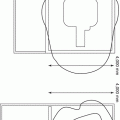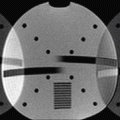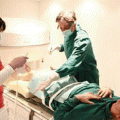(1)
Department of MRI, Medical Center at Siegerland Airport, Burbach, Germany
Magnetic resonance imaging is one of the most fascinating methods of medicine. It has become a symbol of medical progress, as well as the efficiency and potential of modern diagnosis and therapy.
Basically, commercially available MR systems can be divided in two groups: systems with high- and low-field magnetic field strength (Tavernier and Cotten 2005). What is this parameter field strength? What is addressed usually as “field strength” is more precisely, but a little academically, the magnetic flux density. For reason of simplicity, we stick to the expression field strength. It is measured in Tesla (T). The old unit Gauß (G) is still used occasionally. The rate of conversion is 1 T equals 10,000 G.
One G is earth magnetic field strength at equator level.
High-field systems represent the standard – at least in Europe and the USA. They usually possess a closed-bore, superconducting magnet with a magnetic field strength (flux density) of 1.5 or 3 T. There are some stronger magnets (7 T, 9.3 T), but the music plays up to 3 T.
Low-field MRI systems have become rare in German radiological institutes. They are more frequent in countries with government-controlled medical systems (Parizel et al. 1995). These machines usually have an open-designed, permanent magnet with less than 0.5 T field strength.
Leon Kaufman, as an early developer of open MRI, advocated low-field imaging (Kaufman et al. 1989):
Freed from the physical constraints imposed by high field superconducting magnets, opportunities other than lowered cost present themselves. (…), we achieve a considerable reduction in siting needs, services, and increased patient comfort, safety, and access.
Reading this article of Dr. Kaufman, after years of working with high-field MR systems, I wondered whether magnetic field strength is really as decisive for image quality as traditionally assumed. So I asked a good friend, Uwe Thomas, who was working with GE Medical Systems at that time, about their best clinical low-field MRI site in Europe. He told me to see the practice of Drs. Kolbe and Loretan in Brig/Switzerland. On my way to Montreux Jazz Festival, I visited this small, beautiful institute and was deeply impressed by the image quality of the 0.2 T MR system with permanent magnet. While scanning was not as fast as with a high-field system, the device operated very silently and created a pleasant atmosphere. The open design and low noise level predestinated it for patients with claustrophobia or for children. The colleagues told their patients that they used low field strength and were very careful with RF exposure to their body. They took their time, and if the doctor takes time, the patient can take time too. For an abdominal MRI, the patients had to visit twice – and appreciated it – a totally alternative approach in our time, characterized by stress and hecticness.
And image quality was surprisingly good.
As a consequence, I convinced my hospital CEOs to invest in a 0.35 T system, and a few years later in an additional 3 T MRI. This was a dream come true. Every system had its own strengths and weaknesses, and the two machines complemented each other beautifully, working perfectly in combination – clinically, ecologically, and economically. This does not mean that every hospital would be wise to buy three MRI machines, but modern healthcare tends to create networks of larger structures that can easily accommodate a variety of systems – not only to play the high keys, but to play the whole piano.
MR imaging is also a symbol of expensive medicine and for the restriction of medical resources. Despite it may be wishful, not everyone who needs MR imaging has immediate access to it.
The most important cost-driving factor of MRI is field strength (Kaufman et al. 1989). On the other hand, if you ask a manufacturer how to improve MRI quality, the answer in (almost) every aisle of every congress is the same: “increase field strength.”
Public health science demands that, for allocation of medical resources, the rules of cost-effectiveness have to be considered (Töpfer 2007). This is expressed in the so-called economic principle.
There is a tendency to change from “procedure-based” (pay per MRI examination) to “value-based” (high-quality diagnosis and treatment of an appendicitis) payment in medicine. Now, what is value in medicine? The answer to this question could fill another book. To make it short, each medical procedure is subject to cost-effectiveness evaluations. These studies reduce medicine to the essential question: at which price can an additional “quality-adjusted” life year (QALY) be bought? A QALY is a life year with full quality, without disease-related “value reduction.” So one year in intensive care is expensive but no full-value (quality adjusted) life year. A devoted physician knows that medicine doesn’t work this way. But in a time of vanishing resources and a growing number of patients, there has to be some kind of resource distribution control.
This concept can be applied to each medical procedure. For example, MRI is a well-established diagnostic step before knee surgery. But is it cost-effective and is it economical? Mather and coworkers found that alternative strategies without MRI may provide equivalent service at lower costs (Mather et al. 2015). MRI may be an adjunctive, but its cost-effectiveness was found to be suboptimal.
There are two main causes for economic disapproval of a medical method: the method is insufficient (definitely not true for knee MRI) and too expensive. In both cases, the price of an additional QALY is too high. The authors of the abovementioned study work at Duke University. So, if MRI is too expensive for North Carolina, how much true is this for Myanmar or the Ivory coast?
In the USA, the affordable care act (ACA) is changing the role of diagnostic imaging. Radiology becomes more a “cost center” than a revenue generator (Barnes 2013). Radiology, like laboratory medicine, is sometimes considered a “commodity,” a standard good, not appreciated for quality but just by the price (Borgstede 2008).
This will provoke a number of new questions. Are the medical procedures and the way in which they are performed still optimal, or do we need a change?
Of course, an expensive high-field MRI offers considerable marketing potential: The bigger the machine, the better the diagnosis. But is this really true? The patient expects the best possible diagnostic safety, particularly with an expensive method like MRI, but does this really depend on field strength? Don’t we, by emphasizing the importance of large high-field systems, support those who say, “It’s the machine that makes the diagnosis, not the doctor.” Is Radiology a commodity, simply judged by the price? Is it the field strength or the doctors’ skills that make the difference?
In roentgenology, we try to minimize patient exposure to radiation. The “ALARA” principle demands that radiation has to be “as low as reasonably achievable.” We optimize tube voltage and reduce tube current by every means. Of course, more tube current means less noise, but no one would dare to say that increasing tube current is a really good idea for improving image quality in CT. And increasing tube current leads to linear increase of radiation exposure; increasing field strength leads to an increase in RF exposure by a power of 2 (Litmanovich et al. 2014). 3 T MRI means 100 times higher RF exposure than 0.3 T.
How much field strength does an experienced well-trained radiologist really need for high-quality MR imaging? Are the low-field MRI systems as good as possible, or has their development been neglected a little bit, in favor of the high end of the field strength scale?
Stay updated, free articles. Join our Telegram channel

Full access? Get Clinical Tree








